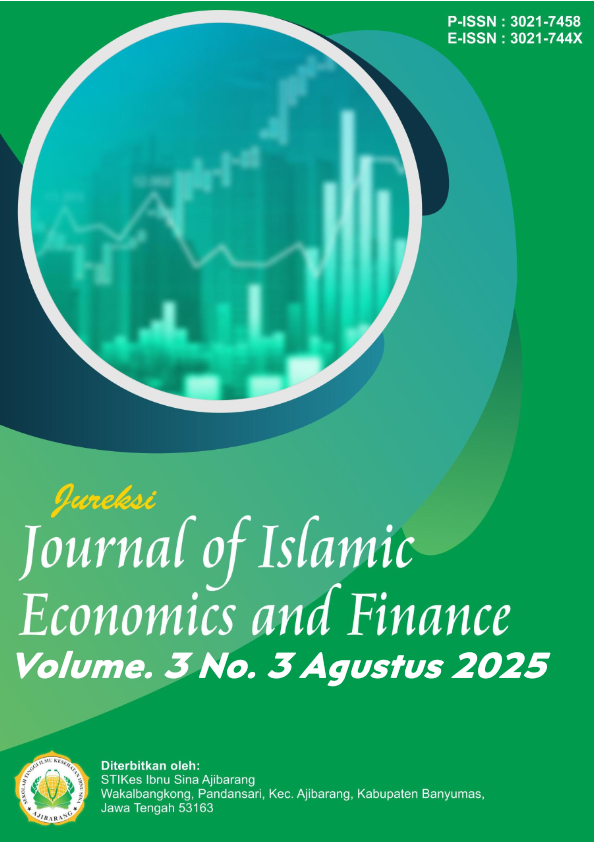Dampak Pemberdayaan Perempuan terhadap Angka Kekerasan dalam Rumah Tangga (KDRT) di Provinsi Maluku Utara
DOI:
https://doi.org/10.59841/jureksi.v3i3.3026Keywords:
Women's Empowerment, Domestic Violence, Gender Empowerment Index (IDG), GRDP per Capita, Home-Based Industry (IR), Domestic Violence SocializationAbstract
The government's efforts to reduce domestic violence (KDRT) in North Maluku Province have been carried out, among others, through the implementation of women’s empowerment programs. This study aims to examine whether the Gender Empowerment Index (IDG), Gross Regional Domestic Product (GRDP) percapita, women's involvement in home-based industries (IR), and the intensity of domestic violence socialization programs have a significant effect on domestic violence rates across districts/cities in North Maluku. This research utilizes panel data regression analysis with data spanning the years 2016–2024. The data were processed using Microsoft Excel and STATA14 software. The findings indicate that the increased participation of women in the economic and political sectors has not yet fully translated into a reduction in domestic violence, largely due to persistent social norms and patriarchal values within households. This suggests that economic factors alone are not sufficient to explain the prevalence of domestic violence. However, women's involvement in home-based industries was found to significantly improve their economic independence and bargaining power within the household. Furthermore, consistent government-led domestic violence awareness campaigns have proven effective in enhancing protection mechanisms for women at risk. In conclusion, the study finds that the Gender Empowerment Index (IDG) and GRDP per capita do not have a statistically significant impact on domestic violence rates. Conversely, women's participation in home-based industries and domestic violence socialization efforts are significantly associated with reductions in domestic violence in North Maluku Province.
References
Abidin, A. Z., Arif, M., & Abroroh, S. A. (2022). Studi keterlibatan perempuan dalam lembaga legislatif dalam indeks pembangunan gender di Provinsi Jawa Barat. Jurnal, 2(1), 23–36.
Antono, H. T., & Lutfi, M. (2014). Variabel-variabel yang berpengaruh terhadap swabakar batubara menggunakan regresi komponen utama.
Badan Pusat Statistik. (2023). Data Indeks Pemberdayaan Gender Provinsi Maluku Utara.
Badan Pusat Statistik. (2023). Data PDRB per Kapita Provinsi Maluku Utara.
Budaya, P., Patriarki, D., & Kaitannya, D. (n.d.). No title. Jurnal, 6, 129–140.
Dinas Pemberdayaan Perempuan dan Perlindungan Anak Kabupaten/Kota Provinsi Maluku Utara. (2023). Data industri usaha rumahan, data sosialisasi KDRT.
Dinas Pemberdayaan Perempuan dan Perlindungan Anak Provinsi Maluku Utara. (2023). Data kekerasan perempuan dan anak.
Eryadini, N., Ratna, N., & Nufus, A. F. (2021). Pengaruh pemberdayaan perempuan terhadap peningkatan ekonomi produktif. Journal of Education and Religious Studies, 1(01), 22–26.
Hafiz, A. (2022). Sosialisasi pencegahan kekerasan dalam rumah tangga di Desa Sandubaya Kecamatan Selong Kabupaten Lombok Timur. Jurnal Pengabdian.
Ibrahim, L. F., Seran, G. G., & Pratidina, G. G. (2019). Implementasi program pemberdayaan perempuan korban kekerasan dalam rumah tangga di Kota Bogor. Jurnal Governansi, 5(1), 89–97. https://doi.org/10.30997/jgs.v5i1.1709
Industri, S. K. D., Menengah, D., Provinsi, N. T. B. (2023). Jurnal, 2(1), 156–174.
Downloads
Published
How to Cite
Issue
Section
License
Copyright (c) 2025 Journal of Islamic Economics and Finance

This work is licensed under a Creative Commons Attribution-ShareAlike 4.0 International License.








